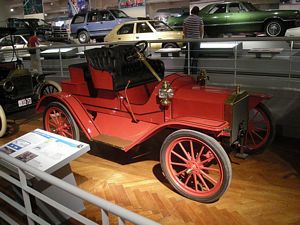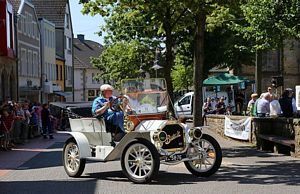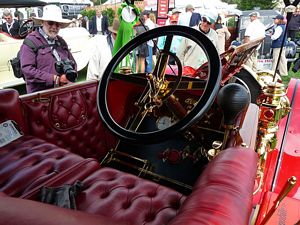|
By accessing or using The Crittenden Automotive Library™/CarsAndRacingStuff.com, you signify your agreement with the Terms of Use on our Legal Information page. Our Privacy Policy is also available there. |

The American Road #8: On The Right Side of History
|
|---|
|
|
 Opinions expressed by Bill Crittenden are not official policies or positions of The Crittenden Automotive Library. You can read more about the Library's goals, mission, policies, and operations on the About Us page.
Opinions expressed by Bill Crittenden are not official policies or positions of The Crittenden Automotive Library. You can read more about the Library's goals, mission, policies, and operations on the About Us page.
|
The American Road #8: On The Right Side of History
Bill Crittenden
March 19, 2015
 1908 Ford Model S, photo by Michael Barera (Creative Commons Attribution-Share Alike 3.0 Unported) 1908 Ford Model S, photo by Michael Barera (Creative Commons Attribution-Share Alike 3.0 Unported)
 1909 Buick, photo by J.-H. Janßen (Creative Commons Attribution-Share Alike 3.0 Unported) 1909 Buick, photo by J.-H. Janßen (Creative Commons Attribution-Share Alike 3.0 Unported)
 1912 Locomobile Model 48 Torpedo, photo by Craig Howell (Creative Commons Attribution 2.0 Generic) 1912 Locomobile Model 48 Torpedo, photo by Craig Howell (Creative Commons Attribution 2.0 Generic)
|
I spend a bit of time reading really old newspaper articles on cars, and I've got to say that it gives one a completely different perspective to read what was considered important at the time rather than the basic "history" that has filtered down through the years. I found one line especially interesting...
Alfred Reeves, General Manager of the American Motor Car Manufacturers' Association, returned yesterday from a tour of inspection of leading motor car factories of the country. Mr. Reeves visited sixty-one factories, and has thoroughly posted himself concerning the 1910 production...
"The most radical change is the placing of the steering wheel on the left hand side. Two of the largest producers and a number of smaller concerns will make this change."
1910 Auto to be Standard Type, July 18, 1909
Say what?
I hadn't really noticed, but then I went through some pictures of old American cars I realized, sure enough, that many of them were right hand drive.
So we've all heard that throughout the pre-automobile world whether one kept to the right or left was related to local customs, and sometimes the stories involve swords and horses but nobody knows anything with 100% certainty. For Britain, customs dictated driving on the left. For the brand-spankin' new United States, driving on the right first appeared in law in 1792.
There are all sorts of justifications for each side, based on passing oncoming traffic and what the driver wants to be able to see from where he sits. Whatever the justifications are, most seem to be issues that could easily have been solved by something as simple as
sitting on the other side of the wagon rather than changing everyone's driving habits, so it seems that the contradictory justifications were come up with
ex post facto, trying to logically justify a left or right custom long after the decision had been made. The only justifications that seem to make any sense have to do with right-handed dominance and the issues of using a whip on horses or oxen.
The important thing is, for whatever reasons they came up with and whenever they came up with them, everybody drove on the same side. There was order and traffic flowed.
However, in the early United States, despite driving on the right side of the roadway, drivers still also sat on the right side of the wagon, out at the edge of the roadway. Why?
It seems to be related to what we called our "roads" back then. I say "roads" with quotes because our relatively young agrarian nation largely got from town to town on a very rudimentary patchwork of dirt ruts that aren't even in the same league as what Rome had built two thousand years prior. So, as the story goes, wagon drivers sat on the right, towards the ditch, to make sure their wagons didn't go in and turn over when passing oncoming traffic. Or maybe wagon drivers sat on the right because it was easier to use their whips right handed, and when they approached an oncoming wagon they stayed to the right to keep an eye on roadside obstacles.
It's hard to tell which came first, the seating position or the passing side? The custom or the justification for it? The chicken or the egg?
By the 1900's our familiarity with this seating position and the general advantages that still applied to rural traffic was what likely led American automakers to put the steering wheels on the right side of their new cars. After all, what were our first automobiles but "horseless carriages," built with much the same materials and techniques as carriage making but with a small engine under the seat replacing the horse?
As the Good Roads Movement in America started getting their individual states to build modern wide paved highways to match our newfangled motor cars the advantages of right hand drive in a right side driving culture faded. Rather than get the entire country's citizens (many of whom still used horse drawn vehicles) to suddenly switch sides of the road, it was easier to get automakers to put the steering wheel on the left side of their new cars.
Ford made this switch with the Model T, even citing the advantage of it in a 1908 brochure citing the ease of passengers exiting on the curb side ("especially ... if there is a lady to be considered"). Again, whether the advertising department played up a unique design feature created by Ford's famously efficient manufacturing (one theory is that left hand drive was easier to build), or whether Ford had other reasons behind his LHD switch, the precise truth is still buried in history.
Regardless of motive, the mass-produced Ford's ubiquity helped solidify left-hand drive as the American standard. Hudson switched in 1914, Locomobile in 1915. Cadillac followed in 1916 with the historic Type 53, the first automobile to use the control system that is still our standard to this day.
The precise story of the switch is still as murky as the puddles that would gather on a rural dirt road back then. I'm sorry I can't find more on this yet. Like a lot of Brass Era history, it just wasn't important enough to include in the general history of the automobile. Stories that resonate with modern times are popular. Henry Ford built the Model T on the first mass production assembly line! General Motors was founded! The rest gets pushed further and further into obscurity with each passing generation. Locomobile? Who's even heard of them anymore? Or the Vanderbilt Cup? Glidden Tours? The Selden Patent? That last one almost killed the Ford Motor Company, and few I've encountered have even heard of it.
But with new resources comes new progress, as The New York Times' archives have helped me discover this switch and then nail it down to a specific year that happens to be different from a lot of other armchair historians' conjectures. Perhaps with the tens of thousands of pages of trade publications that Google is putting online in Google Books we can find a more specific answer someday, but they're as yet very difficult to search (the computer readings of the often smudged print is quite garbled and unusable in many instances).
On a personal note, I prefer left hand drive. Like most people I'm right-hand dominant, but I also fiddle with the radio and the heater controls a lot and I have enough trouble with all of the buttons and knobs in the center of the dashboard without trying to do it all left handed. Obviously this wasn't a consideration when cars had nothing but a choke lever and spark advance to control, before heaters and basic radios, and long before Bluetooth phone connections and satellite navigation could even be predicted let alone implemented, but it's nice to have gotten lucky on this one. I can hang my useless left arm out on the door, keeping my right hand on the wheel, lookin' cool cruising down the country roads. Or it's the left arm holding the wheel steady so the right hand can deftly change station to avoid a Nickelback song.
Not that we need to begin arguing the merits of left hand drive or right hand drive, neither of which will matter when Google is driving all of our cars for us...

















 Opinions expressed by Bill Crittenden are not official policies or positions of The Crittenden Automotive Library. You can read more about the Library's goals, mission, policies, and operations on the About Us page.
Opinions expressed by Bill Crittenden are not official policies or positions of The Crittenden Automotive Library. You can read more about the Library's goals, mission, policies, and operations on the About Us page.
